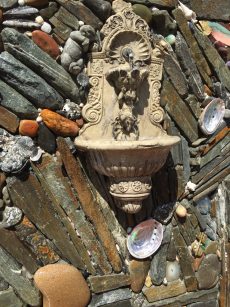
There?s a reason that stone in a garden gives us the feeling that it has been there a long time. The rustic elegance of a dry laid stone wall, natural stone paver patio, huge stone slab steps, outdoor stone fireplace or flagstone garden path reminds us that we humans have used stone for over two million years when we first started making stone tools.
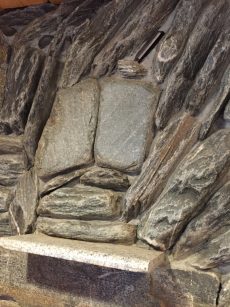
Stone is much more than the Wikipedia definition of ?a naturally occurring solid aggregate of one or more minerals.?? Granite, for instance, comes from igneous rocks formed slowly as it cooled deep under the earth?s surface. Sandstone and limestone are sedimentary rocks formed by the compaction of grains or pieces of any kind of existing rock material then cemented over millions of years by the movement of the earth?s tectonic plates and sometimes contain fossils formed at the time of deposition. Then there is metamorphic rock like marble and slate that were formed at extreme high pressures and temperatures beneath the earth?s crust from other types of rock. The presence of swirls, linear patterns or banding is a key characteristic of this kind of stone.
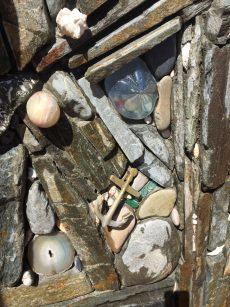
In Ben Lomond lives a stone advocate who has created a spectacular decorative stone wall, a stone shower and sauna room, stone patio, paths and slab steps and he?s invited me to come and view them at his home before he puts it on the market.
Jon Troutner has been in the stone business for a long time. He owned Antolini Masonry and Landscape Supply in Santa Cruz for 20 years until he lost his lease and sold the company in 2008. Afterwards he used his expertise and some choice materials he saved to use at his home in Ben Lomond and another in Aptos. Jon?s primarily a musician these days but his creative vision in stone is a magical experience as he walks me around his home.
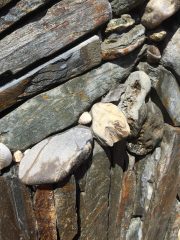
Jon?s property is located near Love Creek up on a hill and has a lovely canyon view. When he bought the property 5 years ago the backyard was just sand but now it is fully landscaped. Ocean Pearl, one of his favorite stone types that he used in his whimsical wall and sauna, comes from a quarry on Vancouver Island that he used to own. Jon gave this this type of quartzite it?s unique name because of the subtle hues and shadings in the stone.
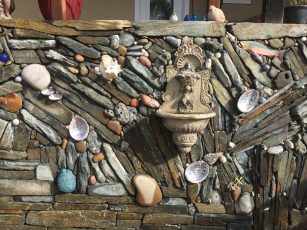
Jon?s creations in stone have a look of their own. Being a harmonica player he puts an old harmonica somewhere on each of his unique walls. It?s his personal signature and he pointed out one in the sauna and one in the ?Where?s Waldo?? wall as he calls it.
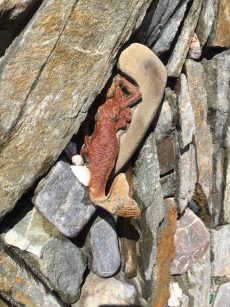
?What?s a ?Where?s Waldo? wall, I ask?” Jon just laughs and explains that this 1987 children?s book is about the travels of Wally where readers are asked to locate him hidden in an illustration and to re-explore each scene locating other objects too. Jon showed me three mermaids, five otters, two turtles, three seahorses and an eel-shaped rock poking out from the ?waves? of ocean pearl stone veneer on the showpiece wall he created to enclose the patio. There are also ship net balls, an anchor, abalone shells, fossils and his signature harmonica. ?I pictured this wall as the ocean floor,? Jon explained.
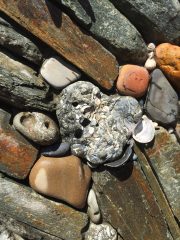
As we walk around, Jon points out the Vermont slate floor and the ocean pearl veneer sauna room, the basalt shower with rounded cobble stone floor, the Indian rainbow cut sandstone shady patio, the Connecticut bluestone slab steps, the ocean pearl columns, the tumbled Arizona gold flagstone path and the 125 pound crystals from Brazil that are lighted at night.
This place is magical and timeless. Jon?s creative vision will live forever in his stone creations.

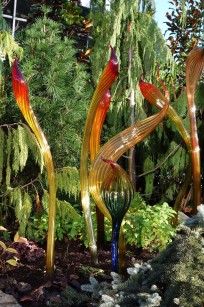
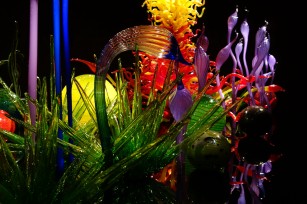
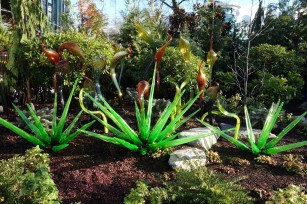
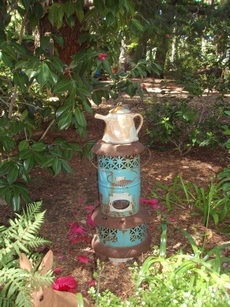 ited bordered their flower beds with small brightly glazed pots overturned on river cobbles. The effect was pure whimsy. I never get tired of the chair-turned-planter whenever I see it in a garden. You can use either a wooden or an ornamental metal chair as long as you can remove the center of the seat so a pot can rest on the frame. Fill with perennial purple wave petunias, red verbena and white geraniums for a July 4th tribute. Shade lovers could use Get Me lilac campanula, Goldilocks lysimachia and dwarf fuchsia’s instead.
ited bordered their flower beds with small brightly glazed pots overturned on river cobbles. The effect was pure whimsy. I never get tired of the chair-turned-planter whenever I see it in a garden. You can use either a wooden or an ornamental metal chair as long as you can remove the center of the seat so a pot can rest on the frame. Fill with perennial purple wave petunias, red verbena and white geraniums for a July 4th tribute. Shade lovers could use Get Me lilac campanula, Goldilocks lysimachia and dwarf fuchsia’s instead.